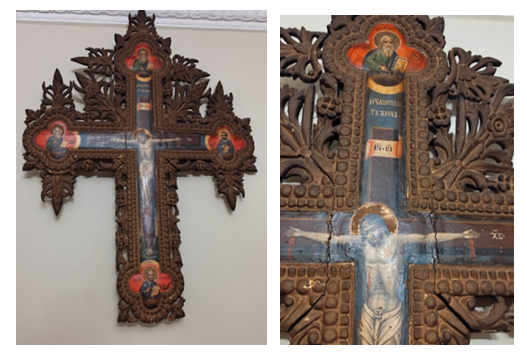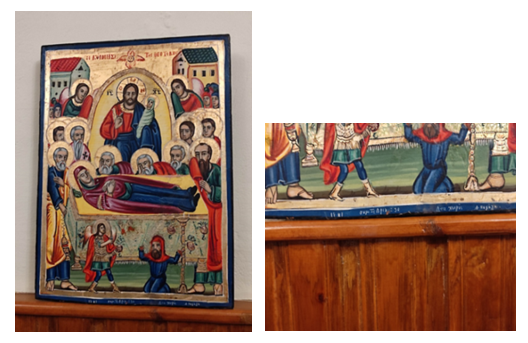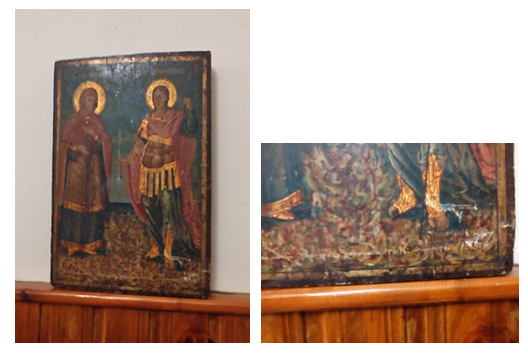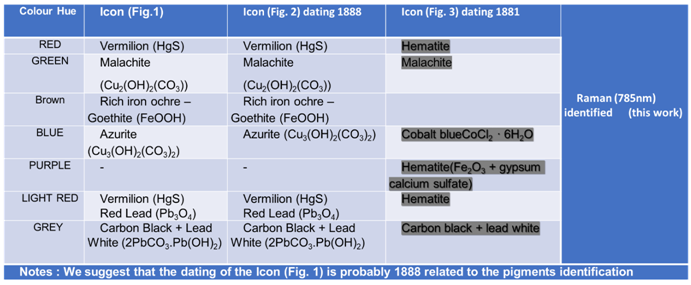-
Paper Information
- Paper Submission
-
Journal Information
- About This Journal
- Editorial Board
- Current Issue
- Archive
- Author Guidelines
- Contact Us
International Journal of Arts
p-ISSN: 2168-4995 e-ISSN: 2168-5002
2023; 12(1): 1-4
doi:10.5923/j.arts.20231201.01
Received: Mar. 14, 2023; Accepted: Apr. 8, 2023; Published: Apr. 15, 2023

The Iconostasis of Panagia Damasta: Pigments Identification in Icons Using N.D.T.
Stella Mouzakiotou1, Panagiotis Douros2, Theologos Alexandrakis3, Theodore Ganetsos2
1Hellenic Open University & University of West Attica, Athens, Greece
2University of West Attica, NDT Laboratory, P. Ralli & Thivon 250, 12244, Athens, Greece
3National and Kapodistrian University of Athens, Athens, Greece
Correspondence to: Theodore Ganetsos, University of West Attica, NDT Laboratory, P. Ralli & Thivon 250, 12244, Athens, Greece.
| Email: |  |
Copyright © 2023 The Author(s). Published by Scientific & Academic Publishing.
This work is licensed under the Creative Commons Attribution International License (CC BY).
http://creativecommons.org/licenses/by/4.0/

On the northern slopes of Mount Kallidromo at an altitude of 740 m., 23 km away from Lamia is built the Monastery of Damasta. The painting of the Catholicon was undertaken at his expense by the fighter of the Revolution Io. Diovouniotis, as evidenced by the surviving inscription above the entrance of the Catholic inscription. Through the present research we will highlight the fragments of the wood-carved iconostasis - baroque style - that have survived and kept in the Monastery, since after the devastating fire it was replaced by a later one. Specifically, the Pyramid of the iconostasis has survived with the Crucifix and the Lypira, that is, the presence of St John and the Virgin Mary. We identified the pigments of the icons using Raman Spectroscopy and XRF portable instruments for in-situ measurements.
Keywords: NDT pigments iconostasis Damasta Raman XRF
Cite this paper: Stella Mouzakiotou, Panagiotis Douros, Theologos Alexandrakis, Theodore Ganetsos, The Iconostasis of Panagia Damasta: Pigments Identification in Icons Using N.D.T., International Journal of Arts, Vol. 12 No. 1, 2023, pp. 1-4. doi: 10.5923/j.arts.20231201.01.
1. Introduction
- On the northern slopes of Mount Kallidromo at an altitude of 740 m., 23 km away from Lamia is built the Monastery of Damasta. There are not many references about its history. Some people believe that the name ‘Damasta' derives from the city of Damascus, the city where the Holy Icon of the Virgin Mary came from. There are also others versions of the origin of the name of the monastery, but one of the most prevalent seems to be the version that it comes from the Greek verb «δαμάζω»=subdue - "damastra“, our Virgin Mary tames pain and passions. The Monastery was burned before the years of the Revolution of 1821. The catholicon is preserved almost intact and has been painted in 1818, and its style is cruciform with a dome, eight-sided symmetrical. However, its initial construction is estimated between the 13th and 15th centuries, based on its typology. The painting of the Catholicon was undertaken at his expense by the fighter of the Revolution Io. Diovouniotis, as evidenced by the surviving inscription above the entrance of the Catholic inscription.According to tradition, the Icon of the Virgin Mary in the type of nursery, which bears no dating and is housed in the catholicon, is a miraculous, came to Greece from the city of Damascus in Syria, birthplace of the great father and Saint of our Church, John Damascene, during the periods of Iconoclasm, in the 8th-9th century.But today we believe that the icon of the Virgin Mary is probably a work of the 16th century, and bears a silver-plated investment of the 19th century (1892). The Monastery took part in the revolution and many of its monks fell on the battlefields. In the offer of the Monastery during the years of the Revolution of 1821, the engraved inscription that exists in the courtyard of the monastery is mentioned.Through the present research we will highlight the fragments of the wood-carved iconostasis - baroque style - that have survived and kept in the Monastery, since after the devastating fire it was replaced by a later one. Specifically, the "Pyramid" of the iconostasis has survived with the "Crucifix" and the "Lypira", that is, the presence of St John and the Virgin Mary. It is a fact that most of the decorative elements of woodcarving art originate from the early Christian era and then from the Byzantine era, but we must not overlook that significant changes have taken place that are mainly identified with the spirit and the artistic rhythm of the various historical periods and especially with the rhythms that were born and developed in the West during the Baroque period [6]. The detailed examination of certain elements aims at exploring their evolutionary course until their final formation and at searching for the source from which the creators inspired them. In our effort to approach and analyze the decorative parts of our iconostasis in combination with the Byzantine past and the Western artistic styles, we are led to examine them from the lowest points to the top, following the architectural functionality of their parts and always compared to similar sculptural ensembles of the same geographical area, of an earlier or later era.
 | Figure 1a. Part of iconostasis with details |
 | Figure 1b. Icon 1 with more details in colours |
 | Figure 1c. Icon 2 with more details in colours |
2. Methodology
- The measurements of pigments in icons of the Monastery of Damasta were conducted using Raman Spectroscopy and XRF both non-destructive techniques.Τhe instrument which was used for Raman Spectroscopy was the portable DeltaNu RockHound with 785 nm laser source, the resolution was 8 cm-1 and the spectral range was from 200 to 2000 cm-1.
 | Figure 2. XRF (up) and Raman Spectroscopy (down) are the portable instruments we used for in-situ measurements |
|
 | Figure 3. Raman spectroscopy identification of the red colour as vermillion |
3. Experimental Results
- I. Black colourWe identified using Raman Spectroscopy Bone black (Experimental Raman peaks: 961cm-1, 1325cm-1, 1580cm-1) which is a finely ground material obtained by carbonizinrg (charring) animal bones and containing around 10 to 20% carbon. The rest of the material consists of hydroxyapatite (basic calcium phosphate Ca5(OH)(PO4)3) and calcium sulfate.II. Daark Blue colour We identified using Raman Spectroscopy Azurite (Experimental Raman peaks: 403cm-1, 746cm-1, 839cm-1, 1098cm-1) which is basic copper (II)-carbonate: 2 CuCO3·Cu(OH)2 forming bright blue crystals. The pigment has been prepared either from naturally occurring mineral or produced synthetically.III. Red colourWe identified Vermilion (cinnabar), (Experimental Raman peaks: 252cm-1, 282cm-1, 343cm-1) is mercuric sulfide with the formula HgS. The oldest form of vermilion is finely ground mineral cinnabar. Mercuric sulfide can also be produced artificially.IV. Light Blue colourWe identified the Cobalt blue (Experimental Raman peaks: 203cm-1, 512cm-1), is a mixed oxide of cobalt and aluminum CoO • Al2O3. It can also be considered to be cobalt (II)-aluminate with the formula of CoAl2O4.V. Green colourWe identified Malachite (Experimental Raman peaks: 433cm-1, 553cm-1, 1492cm-1) which is a basic copper carbonate with the chemical formula of CuCO3 · Cu(OH)2.VI. Brown colourWe identified red ochre, (Experimental Raman peaks: 220cm-1, 286cm-1, 402cm-1) the main color giving component of natural red ochre (ocher) is composed of hematite (∝-Fe2O3). The term red ochre (ocher) or red earth describes various kinds of iron oxide pigments such as Venetian red, mars red, English red, Indian red.
4. Conclusions
- Analytical investigation of the icons and iconostasis, has shown that it consists of the materials well known and widely in use in painting of 16th century. Pigments detected with Raman spectroscopy are: for blue azurite and cobalt blue, malachite for green, vermilion for red, and fro black the bone black pigment.
ACKNOWLEDGMENTS
- The authors would like to express their special thanks to the monk and abbot of the Monastery of Damasta for providing help with conducting the measurements.
 Abstract
Abstract Reference
Reference Full-Text PDF
Full-Text PDF Full-text HTML
Full-text HTML